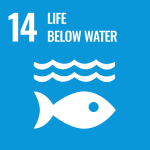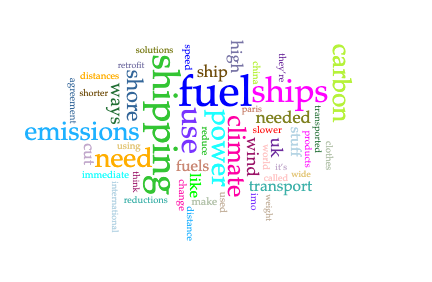Unit 4 Innovation: SDG14
Life Below Water

Goal no. 14 of the 2030 Agenda for Sustainable Development aims to conserve and sustainably use the oceans, seas and marine resources for sustainable development.
Click on the arrows to reveal more information about SDG14. You don’t need to remember everything you read – the main thing is to get an overview of this Goal.
Information and targets reproduced under the terms and conditions of United Nations websites. Copyright (2023).
A reminder that links in this e-book do not open in a new tab. If you click on any of the links to a webpage, click the back button in your browser to return here.
Key vocabulary
Check that you know the meaning and the whole word family of these key words before you begin the Unit. (NOTE: there may be other versions of the word forms – these are the common forms in the context of SDG 14). Also notice some common collocations in bold in the ‘Why this goal? and ‘Targets’ sections above. Add any new words, word families or collocations that you would like to remember to your vocabulary book.
Verb Noun Noun person Adjective
To conserve conservation conservationist conserved
To inhabit habitation inhabitant habitable/inhabitable
To be biodiverse biodiversity biodiverse
To exploit exploitation exploiter exploited
To pollute pollution/pollutant polluter polluting
Introduction
In Unit 3 you learned a bit about the impact of the textile industry on the environment. In this Unit you’ll find out about the way the industry relies heavily on water, a precious natural resource. Read the paragraph and answer the questions below:
The textile industry is responsible for 10% of global carbon emissions. It produces up to 20% of industrial wastewater pollution, and textile dyeing is the second largest polluter of water globally. Making a pair of jeans takes approximately 7,570 litres of water.
- Can you think of ways in which the textile industry makes such a huge contribution to greenhouse gas emissions?
- What does textile ‘dyeing’ refer to? Can you give the verb, noun and adjective?
- Do you wear jeans? Were you aware how much water it takes to make them?
Reading – Following a t-shirt from cotton field to landfill shows the true cost of fast fashion
Before you read
In the UK, ‘Black Friday’ is a day when consumer goods are discounted in order to encourage people to buy more. In 2020 one of the discounted products was a dress that a retailer was selling for 8p (0.08 Euros, or 0.12 US dollars), when it would probably cost around £20 usually (23 Euros or 25 US dollars).
- Based on what you learned in Unit 3, what problems do you think are created or exacerbated by retailers selling clothes so cheaply?
- What do you think of the idea of persuading consumers in developed countries to buy more than they need?
Read for main ideas
Read the text (max 10 mins) and identify the problems at each stage in the production process of a t-shirt. Drag the problems into the relevant sections.
Read for detail
Complete the gaps in the paragraph by writing in an appropriate word or phrase from the text.
Following a t-shirt from cotton field to landfill shows the true cost of fast fashion

With many shops closed due to pandemic restrictions, Black Friday 2020 might have looked different from the frantic buying sprees of years past. But one thing remained the same: the relentless pace of fast fashion. Environmentalists criticised one UK retailer for selling a dress for 8p online.
What are the costs of making garments so cheap? Well, consider an item of clothing we’re all likely to wear at some point – the t-shirt. Like the 8p dress, t-shirts belong to an industry responsible for 10% of global CO₂ emissions.
Depending on the brand of t-shirt you’re wearing, you could be contributing to these emissions and a long list of other environmental and social harms. But to really understand these impacts, we need to explore the supply chain that creates them.
Spinning a yarn
Most t-shirts are made from cotton, which is grown in 80 countries by 25 million farmers who produced a total of 25.9 million tonnes of fibre between 2018 and 2019. Conventional cotton farming consumes 6% of the world’s pesticides, even though it only uses 2.4% of the world’s land. These chemicals control pests like the pink boll worm, but they can also poison other wildlife and people. Farmers tend to use large amounts of synthetic fertiliser to maximise the amount of cotton they grow, which can degrade soil and pollute rivers.
More than 70% of global cotton production comes from irrigated farms and it takes one-and-a-half Olympic swimming pools of water to grow one tonne of cotton. Your t-shirt could have used 7,000 litres of water just to grow the cotton it’s made from. That’s a lot of water for one t-shirt, especially when you consider that cotton is a crop that tends to be grown in regions plagued by drought. The farmer may have only 10l to 20l of water a day for washing, cleaning and cooking.
But the negative impacts only begin with growing the fibres. The cotton has to be spun into yarn, which uses lots of energy and is the second-highest source of carbon pollution across the t-shirt’s lifecycle, after the dyeing process.
The cotton yarn is then knitted into the fabric that makes the t-shirt. Globally, this process generates an estimated 394 million tonnes of CO₂ per year.
Finishing touches
Next, colour is added to the fabric. This can be done in many different ways, but all rely on fresh water, which may become contaminated with tiny fibres or chemicals harmful to animals and plants. In some cases, this water is discharged directly into the environment without treatment. In Cambodia for example, where clothing comprises 88% of industrial manufacturing, the fashion industry is responsible for 60% of water pollution.
The dyeing process uses lots of energy to heat the water, as most dye reactions occur at 60°C or higher. The coloured fabric then has to be washed and dried to prepare it for the final stage: garment making. Overall, it takes about 2.6kg of CO₂ to produce a t-shirt – the equivalent of driving 14km in a standard passenger car.
Transporting the t-shirt to your house accounts for less than 1% of the garment’s total emissions. But once there, it consumes energy, water and chemicals. Washing, ironing and drying clothes represents one-third of the overall climate impact of clothing. Synthetic clothes, made of materials like polyester, generate tiny plastic fibres when washed, which eventually flow into rivers and the sea. Research suggests that synthetic fabrics are responsible for up to 35% of all the microplastics polluting the ocean.
Sadly, the average number of times a garment is worn before being thrown away is falling. In the UK, more than £40 billion (US$53 billion) worth of clothing sits at the back of wardrobes. When emptied, 350,000 tonnes of clothing ends up in landfill each year. Often these garments still have plenty of life in them if they are given the chance – 90% of donated clothes are suitable for racks in UK charity shops. But this relies on consumers saving old clothes from the bin.
Changing clothing
It’s a myth that fast fashion clothing is necessarily poor quality. Many brands do create durable products, some lasting twice as long as designer label equivalents that are up to ten times more expensive.
A growing number of businesses are trying to minimise the environmental impact of their clothes. Some UK brands have begun sourcing cotton which is less reliant on pesticides, synthetic fertilisers and consumes less water. Enough high-quality cotton can be grown to meet current demand with much less water and pesticides.
Cold pad batch dyeing uses up to 50% less water, energy and chemicals than standard processes and produces much less waste. Voluntary initiatives, such as the Sustainable Clothing Action Plan, are trying to set minimum standards for quality across the industry.
You can make a difference too. Buying from responsible brands is a good start, and only washing the garment when it really needs it. Once you’re done with your clothes, giving them to clothing charities offers them a second life and makes fashion overall much greener.
Hopefully knowing more about the vast effort and resources that go into making our clothes can help people make better choices as well. Before throwing old clothes out, remember the long and costly journey your t-shirt took from cotton to wardrobe, and think again.
NB This version of the article, with permission from the author, does not include the hyperlinks to supporting articles found in the original. Click the title for the full version of the text, published under a CC BY ND licence in The Conversation, which should be used for reference and sharing.
After you read
What is your reaction to:
- the statistics about how much water is needed to produce cotton, and how much water is needed to produce one t-shirt?
- the information about the farmers who grow the cotton?
- the juxtaposition between water use for a) growing cotton and b) the farmers’ daily lives?
Pronunciation – Silent letters
- Many English words have letters that are not pronounced, and we call them ‘silent’ letters. Read the sentences from the text and for each of the words in bold identify the silent letter that is not pronounced. Try saying the word out loud and seeing which letter is silent. For example, in the word ‘could’, in the first sentence, the letter ‘l’ is not heard.
a) You could be contributing to these emissions and a long list of other environmental and social harms.
b) Most t-shirts are made from cotton.
c) Fresh water may become contaminated with tiny fibres or chemicals.
d) The coloured fabric then has to be washed and dried to prepare it for the final stage: garment making.
e) Hopefully knowing more about the vast effort and resources that go into making our clothes can help people make better choices as well.
f) Before throwing old clothes out, remember the long and costly journey your t-shirt took from cotton to wardrobe, and think again.
2. Listen to the sentences. You’ll hear the sentence first followed by just the word(s) with a silent letter. Check that you identified the silent letter correctly, then listen and repeat the words with silent letters.
Play the audio here.
Vocabulary – Negative environmental impacts
The text (‘Following a t-shirt from cotton field to landfill’) talks about the harmful effects of the fashion industry on the environment. Read the three sentences from the text, noticing the words or phrases in bold. After each sentence, write your answers to the questions in the text box. When you have finished, use the ‘check’ button to see if you have used the expected keywords, and use the ‘show solution’ button to see a sample answer.
- ‘T-shirts belong to an industry responsible for 10% of global CO₂ emissions… You could be contributing to these emissions and a long list of other environmental and social harms.’
2. Conventional cotton farming consumes 6% of the world’s pesticides. These chemicals control pests but can also poison other wildlife and people.
3. Farmers tend to use large amounts of synthetic fertiliser to maximise the amount of cotton they grow, which can degrade soil and pollute rivers.
Writing – Summary
Write five or six sentences that summarise the impact of the lifecycle of a t-shirt on the world’s water supplies.
Function – Expressing caution
- Read this paragraph from the text that contains a lot of statistical information. Notice that the present tense (both active and passive voice) is used to talk about something definite.
‘Most t-shirts are made from cotton, which is grown in 80 countries by 25 million farmers who produced a total of 25.9 million tonnes of fibre between 2018 and 2019. Conventional cotton farming consumes 6% of the world’s pesticides, even though it only uses 2.4% of the world’s land. These chemicals control pests like the pink boll worm, but they can also poison other wildlife and people. Farmers tend to use large amounts of synthetic fertiliser to maximise the amount of cotton they grow, which can degrade soil and pollute rivers.’
2. In the final sentence does the writer say farmers always use synthetic fertilisers, or is he cautious about saying that?
3. Read these sentences from the text and decide what the writer is trying not to say in each one. For example, in the first sentence the writer is trying to avoid saying that all farmers always use synthetic fertilisers. He is cautious about over-generalising.
- Farmers tend to use large amounts of synthetic fertiliser to maximise the amount of cotton they can grow.
- Consider an item of clothing we are all likely to wear at some point – the t-shirt.
- Cotton is a crop that tends to be grown in regions plagued by drought.
- In some cases, the contaminated water is discharged directly into the environment.
- Research suggests that synthetic fabrics are responsible for up to 35% of all the microplastics polluting the ocean.
Practice
Grammar review – Gerunds and infinitives
In Unit 3 you learned that when you have two verbs in a sentence, the first verb dictates the form of the second one. In this extract from the text notice the verbs in bold and decide what form the second verb(s) in brackets should take. You can check by re-reading the paragraph in the Function section above.
‘These chemicals control pests like the pink boll worm, but they can also (to poison) other wildlife and people. Farmers tend (to use) large amounts of synthetic fertiliser (to maximise) the amount of cotton they grow, which can (to degrade) soil and pollute rivers.’
Listening – 10 ways to cut shipping’s contribution to climate change (6 mins)

Before you listen
In the Introduction you learned that the textile industry is responsible for 10% of global carbon emissions, and that the logistical requirements of transporting goods globally at the various stages of production and distribution contribute to textiles’ carbon footprint. Just over one-fifth of CO₂ emissions that cause global warming come from how people get around, send and receive goods and travel the world. One of the sectors doing the most damage in terms of carbon emissions is international shipping. Ships last for decades and run largely on diesel – the most polluting type of fossil fuel. A 20% reduction in ship speeds can save about 24% of CO₂. You’ll hear about speed, as well as 6 other areas where it’s possible to cut shipping emissions.
- A priority is the need to reduce the amount of fuel needed for shipping by transporting less stuff. Think about what you know about being a responsible consumer, and about the circular economy and fast fashion. Predict what the text will say about the environmental costs of shipping fashion items halfway round the world to meet consumer demand.
- In Unit 3 you learned about SDG7 Affordable and Clean Energy. You’ll hear about the potential for ships to use wind power while at sea, and to use electricity when they are in port. Can you guess how these techniques might work?
- Look at the word cloud created from the transcript. The most frequently used words (the biggest ones in the image) are: fuel (12); shipping (8); ships (7); use (6); power (5); climate (5); carbon (5). With the idea of cutting shipping emissions in mind, create a sentence that uses as many of these words as possible and predicts the main point of the listening.

Listen
You will hear the first 6 of 10 ways to cut shipping’s contribution to climate change.
Listen to the introduction about the emissions resulting from international shipping until you hear the information required to complete the first part of the task. Continue listening and make notes under each of the 6 headings. Stop and start the audio if you need to.
Speaking
- Use your notes to make an oral summary to your partner about the process of transporting goods around the world by ship.
- Discuss:
- In the context of SDG14 Life Below Water, why is it important to focus on shipping?
- In the context of fast fashion, what can consumers in the developed world do to help reduce the carbon emissions associated with shipping goods?
Download Unit 4 Listening Transcript
Writing
In this Unit you’ve learned about the way the textile industry and the shipping of ‘fast fashion’ items around the world is responsible for a huge amount of CO2 emissions. In the infographic you learned how the oceans absorb this additional CO2 which threatens marine life. Navaratnam Rasakulam’s story is about how his skills as a fisherman helped him develop an environmentally sustainable technique of raising sea cucumbers (a marine animal in the same family as a starfish) that helps to ensure wild populations are protected. Navaratnam lives in Sri Lanka.
Read Navaratnam’s story and write a response to it that incorporates what you know about innovation and SDG14 Life Below Water. Write about:
- Why Navaratnam began farming sea cucumbers.
- Why farming sea cucumbers, rather than just catching them in the wild, was both innovative and important.
- Any other topic relevant to innovation or SDG14.
Making a New Wave
Navaratnam Rasakulam is the first person to start cucumber farming in the coastal village of Pallikuda in Sri Lanka, a thriving industry that is supporting the livelihood of hundreds of families in the region. “I have been engaging in fishing since I was 16 years old. From a young age, I was interested in and wanted to get into the sea cucumber business. So, whenever I am out fishing, I used to gather sea cucumber in small quantities,” recalls Rasakulam.
When Rasakulam first started farming the animal, there was little domestic demand for it. However, sea cucumbers have become a coveted ingredient in East Asia and Sri Lanka exported 318 metric tons in 2020, generating a revenue of over 1.8 billion rupees. With the soaring demand, wild sea cucumber population was under threat of overexploitation and declining in recent past. Rasakulam understood that his source of income could be at stake and sought to artificially-breed juvenile sea cucumbers from a hatchery. Hatchery based artificial breeding is the most environmentally sustainable technique of raising sea cucumbers and helps to ensure wild populations are protected.
Now, over 190 sea cucumber farms operate in Sri Lanka. Rasakulam takes pride in spearheading this movement, “After seeing the success of my farm, now in Pallikuda, several others have also started their own sea cucumber farms with the support of the National Aquaculture Development Authority (NAQDA) and ILO. I am very happy about this; I want everyone to prosper.”
Department of Economic & Social Affairs Statistics Division (2022) ‘Bringing Data to Life: SDG impact stories from across the globe.’ Available at: https://unstats.un.org/sdgs/report/2022/SDG2022_Flipbook_final.pdf
Data visualisation – Our ocean is endangered
In Unit 3 you learned that global carbon dioxide (CO2) emissions from energy combustion and industrial processes are going up and that much of the CO2 is absorbed by the oceans, which is having a harmful effect. Here you’ll learn more about factors that are endangering our oceans. Read the infographic and complete the task below. (Click here to see the infographic full screen).

Download the transcript here: Unit 4 Infographic
Speaking
Read the summary below and discuss the questions that follow:
SDG14 Summary
The oceans cover more than 70% of the surface of our planet and play a key role in supporting life on earth. They are the most diverse and important ecosystem, contributing to global and regional elemental cycling, and regulating the climate. The ocean provides natural resources including food, materials, substances, and energy.
Increasing levels of debris in the world’s seas and oceans is having a major and growing economic impact.
Oceans, seas and other marine resources are essential to human well-being and social and economic development worldwide. Their conservation and sustainable use are central to achieving the 2030 Agenda, especially for Small Island Developing States. Marine resources are particularly important for people living in coastal communities, who represented 37% of the world’s population in 2010. Oceans provide livelihoods, subsistence and benefits from fisheries, tourism and other sectors. They also help regulate the global ecosystem by absorbing heat and carbon dioxide (CO2) from the atmosphere. However, oceans and coastal areas are extremely vulnerable to environmental degradation, overfishing, climate change and pollution.
Reproduced with kind permission of the UN Environment Programme. Copyright (2023). All rights reserved.
- You’ve learned about the substantial impact fast fashion has on life below water, about plastics polluting the oceans and killing marine creatures, and about the carbon emissions that cause global warming created by the shipping industry. What, in summary, do you think is the main reason we should be taking better care of life below water?
- Fossil-fuelled transport such as shipping worsens severe weather, and severe weather interferes with mobility. Given this vicious circle did any of the suggestions in the listening for ways to cut shipping emissions seem sensible to you?
- Can you give a definition for the words in bold above?
A reminder that if you have access to the internet and are studying by yourself without other people to practice your spoken English with, you can use artificial intelligence (AI) to gain fluency practice. See here for instructions and prompts.
Here are some prompts related to this Unit:
- ‘Let’s have a dialogue about the ethics of persuading consumers in developed countries to buy more than they need. You begin, and ask me what I think about each point that you make.’
- ‘Let’s talk about what are the main reasons that we should be taking better care of life below water? Ask me for my opinion and agree or disagree with me.’
Extension activities
After every two Units you are offered a choice of extension tasks. Use the menu bar on the left-hand side of the screen to access Extension Activities Units 3 and 4.
End of Section One – Resource Use
This is the end of Section 1. Think about:
- Four key things that you found out by working through the topics (SDG12 Responsible Consumption and Production, SDG7 Affordable and Clean Energy, SDG9 Industry, Innovation and Infrastructure, and SDG14 Life Below Water).
- One language skill that you think you have developed a bit further.
- Some new vocabulary items that you have mastered (i.e. you can remember them and use them appropriately).
- An area of language that you would like to develop further.
- Any lifestyle change that is possible in your context to help achieve the aims of one or more of these SDGs.

